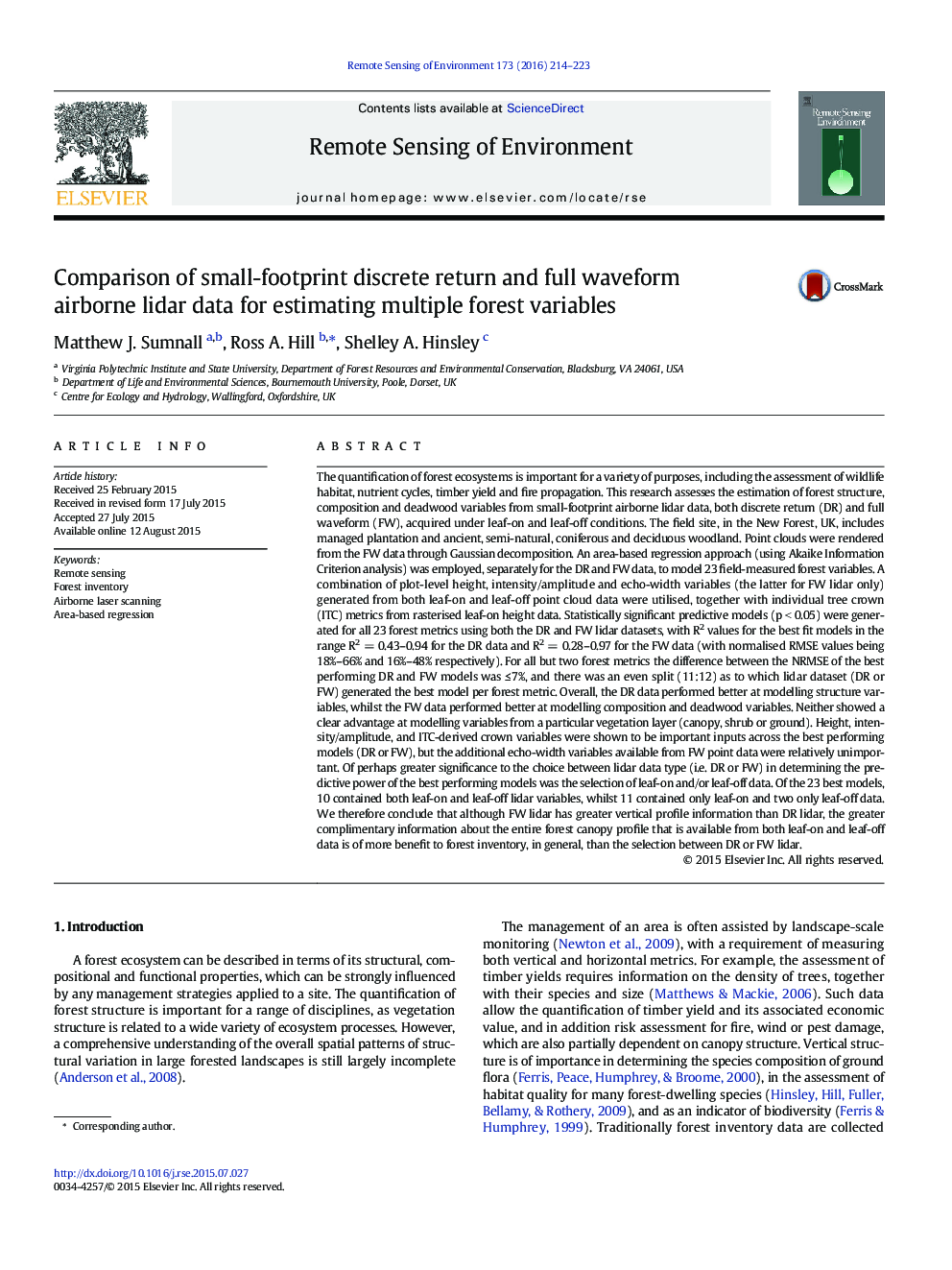| کد مقاله | کد نشریه | سال انتشار | مقاله انگلیسی | نسخه تمام متن |
|---|---|---|---|---|
| 6345675 | 1621227 | 2016 | 10 صفحه PDF | دانلود رایگان |
عنوان انگلیسی مقاله ISI
Comparison of small-footprint discrete return and full waveform airborne lidar data for estimating multiple forest variables
ترجمه فارسی عنوان
مقایسه مقادیر بازگشتی جداگانه کوچکی با رد پای داده و داده های لیدار هوایی کامل برای برآورد متغیرهای جنگل چندگانه
دانلود مقاله + سفارش ترجمه
دانلود مقاله ISI انگلیسی
رایگان برای ایرانیان
کلمات کلیدی
سنجش از دور، موجودی جنگل، اسکنر لیزری هواپیما، رگرسیون مبتنی بر محدوده،
موضوعات مرتبط
مهندسی و علوم پایه
علوم زمین و سیارات
کامپیوتر در علوم زمین
چکیده انگلیسی
The quantification of forest ecosystems is important for a variety of purposes, including the assessment of wildlife habitat, nutrient cycles, timber yield and fire propagation. This research assesses the estimation of forest structure, composition and deadwood variables from small-footprint airborne lidar data, both discrete return (DR) and full waveform (FW), acquired under leaf-on and leaf-off conditions. The field site, in the New Forest, UK, includes managed plantation and ancient, semi-natural, coniferous and deciduous woodland. Point clouds were rendered from the FW data through Gaussian decomposition. An area-based regression approach (using Akaike Information Criterion analysis) was employed, separately for the DR and FW data, to model 23 field-measured forest variables. A combination of plot-level height, intensity/amplitude and echo-width variables (the latter for FW lidar only) generated from both leaf-on and leaf-off point cloud data were utilised, together with individual tree crown (ITC) metrics from rasterised leaf-on height data. Statistically significant predictive models (p < 0.05) were generated for all 23 forest metrics using both the DR and FW lidar datasets, with R2 values for the best fit models in the range R2 = 0.43-0.94 for the DR data and R2 = 0.28-0.97 for the FW data (with normalised RMSE values being 18%-66% and 16%-48% respectively). For all but two forest metrics the difference between the NRMSE of the best performing DR and FW models was â¤Â 7%, and there was an even split (11:12) as to which lidar dataset (DR or FW) generated the best model per forest metric. Overall, the DR data performed better at modelling structure variables, whilst the FW data performed better at modelling composition and deadwood variables. Neither showed a clear advantage at modelling variables from a particular vegetation layer (canopy, shrub or ground). Height, intensity/amplitude, and ITC-derived crown variables were shown to be important inputs across the best performing models (DR or FW), but the additional echo-width variables available from FW point data were relatively unimportant. Of perhaps greater significance to the choice between lidar data type (i.e. DR or FW) in determining the predictive power of the best performing models was the selection of leaf-on and/or leaf-off data. Of the 23 best models, 10 contained both leaf-on and leaf-off lidar variables, whilst 11 contained only leaf-on and two only leaf-off data. We therefore conclude that although FW lidar has greater vertical profile information than DR lidar, the greater complimentary information about the entire forest canopy profile that is available from both leaf-on and leaf-off data is of more benefit to forest inventory, in general, than the selection between DR or FW lidar.
ناشر
Database: Elsevier - ScienceDirect (ساینس دایرکت)
Journal: Remote Sensing of Environment - Volume 173, February 2016, Pages 214-223
Journal: Remote Sensing of Environment - Volume 173, February 2016, Pages 214-223
نویسندگان
Matthew J. Sumnall, Ross A. Hill, Shelley A. Hinsley,
